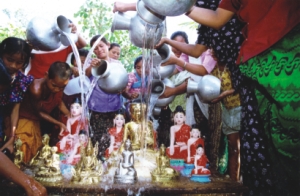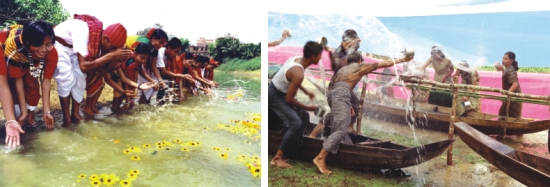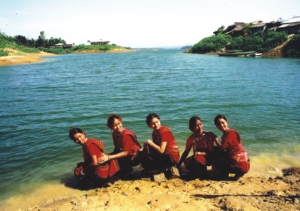|
Culture
For a vibrant adivasi literature
Ekram Kabir in Rangamati
When I met Mrittika Chakma -- an adivasi cultural activist from Chittagong Hill Tracts -- in Dhaka, little did I realise how passionate he was about the Biju festivals in the hills. Accepting his invitation, when I came to Rangamati, I found out he was also a renowned writer and poet, treasured by the hills people as a valuable bridge between all existing indigenous cultures in CHT and Bengali mainstream one.
 Come Chaitra, the adivasis in CHT get ready for celebrating the end of the years as well as the New Year, similarly as we look forward to Eid, Pujas and Christmas. Having a cursory idea on it, I researched a bit. Come Chaitra, the adivasis in CHT get ready for celebrating the end of the years as well as the New Year, similarly as we look forward to Eid, Pujas and Christmas. Having a cursory idea on it, I researched a bit.
Calling it "Boishobi", the adivasis celebrate this festival for wiping away the distresses of the outgoing year and greeting the new one. This is also a spiritual quest for each adivasi, who brims with joy and happiness during this celebration.
The Chakmas call it Biju, the Tripuras Boishuk and Marmas term it Shangraing. Together, they form "Boishobi". Although the carnival relates to the three communities, all adivasi groups as well as the Bangalis in CHT celebrate it. The occasion includes rallies, a range of cultural shows, art exhibitions and Boli khela (wrestling).
The Chakmas, the largest ethnic community, celebrate the three-day festival in phases. As part of the rituals, young girls clean up their houses and float flowers in water, young people would cook pazon, a dish of seven vegetables, to feed guests. They believe the pazon is their hedge against diseases in the New Year.
Tripuras begin with bathing the elderly people and offering them clothes. They believe the ritual would bring them good luck. The Marmas organise 'water session' when young girls spray water jets to one another. Before frisking in the water game, they offer jolpuja.
Indigenous alcoholic drinks such as dochoani, jogorah and kanji also consumed in large amounts by the celebrating adivasis.
I find myself in a colourful inauguration of a four-day ceremony organised by Jum Aesthetic Council (JAC). Celebrating the Boishabi for the ninth time this year, from April 6 to April 9, JAC received support from UNDP and European Union, which are in the middle of an all-out development campaign in CHT, home to Chakma, Marma, Tripura, Mro, Lusai, Khumi, Bom, Pankho, Khiang, Chak and Tanchongya.
Organising cultural events for furthering the adivasi cultures in CHT was not an easy task. There was a time when conflict reigned supreme in the hills and, I learnt, a majoritarian cultural upheaval was on the verge of crushing the cultural diversity of the region. It was at that time 1981 when a group of intrepid young men risked a lot for, first, conserving the traditional culture, and then, promoting it. They formed JAC, initially known as Rangamati Aesthetic Council. The pre-peace treaty era was a disillusioned one as far as indigenous cultural propagation was concerned.

Although the full implementation of the peace treaty, singed in 1997, is a long way off, Jhimit-Jhimit Chakma explains to me how it has created an atmosphere for holding such cultural events. However, he emphasises, these events are still far away from true promotion of adivasi cultures. These are still their frantic attempts from keep their culture afloat in the face of a onslaught of a majoritarian one.  A good suggestion comes from the chief guest of the event, poet Asad Chowdhury. If the adivasis really mean a promotion of their cultures, they, he suggests, have to come forward to create literature such as novels, short stories and poetry in their own language as well as in Bangla and English. Writing in the latter two languages will get a huge audience. A good suggestion comes from the chief guest of the event, poet Asad Chowdhury. If the adivasis really mean a promotion of their cultures, they, he suggests, have to come forward to create literature such as novels, short stories and poetry in their own language as well as in Bangla and English. Writing in the latter two languages will get a huge audience.
I cannot agree more with him. I alerted Mrittika Chakma about it: if adivasi people don't start writing, someone else would. And it would be a very shameful for them if Bangali literatures start producing adivasi literature. It is the adivasis themselves who need to come forward in this sector. The CHT region is full of elements suitable for the making of good novels, short stories and poems. All aspects of lives of the hill people are excellent ingredients for theatrical performances.
Unfortunately, little effort has been made for preserving and building on the magnificent adivasi languages in Bangladesh. Doing so is not an insurmountable task. We Bengalis don't have to toil for it; all it needs is to provide support to adivasi scholars for the purpose. Given the population and rising literacy in the region, is won't be too difficult to inspire them to write books in their own language.
There's hope, many say. To their delight, participants in the festivals came to know that dictionary of adivasi words may be in the offing by one of the development partners of Bangladesh. If that happens, it certainly would help the indigenous people to start producing literary works in their own languages. If that happens, the day may not be far away when Bangladeshi TV channels come forward to broadcast play in those languages as well as in Bengali. I'm sure efforts by Mrittika, Jhimit-Jhimit and Shishir will get true recognition then.
Ekram Kabir is a freelance writer.
Photos: Syed Zakir Hussain
Note: This year many indigenous communities announced they would not celebrate Boishabi, the biggest traditional festival, in protest of the attacks on adivasis in various areas of Khagrachhari that have left at least 60 people injured. Copyright
(R) thedailystar.net 2006 |
